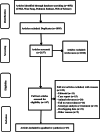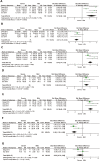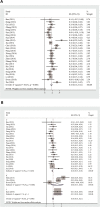Severe fever with thrombocytopenia syndrome: a systematic review and meta-analysis of epidemiology, clinical signs, routine laboratory diagnosis, risk factors, and outcomes
- PMID: 32758175
- PMCID: PMC7409422
- DOI: 10.1186/s12879-020-05303-0
Severe fever with thrombocytopenia syndrome: a systematic review and meta-analysis of epidemiology, clinical signs, routine laboratory diagnosis, risk factors, and outcomes
Abstract
Background: Severe fever with thrombocytopenia syndrome (SFTS) is an emerging infectious disease with the high case-fatality rate, and lack of vaccines. We aimed to systematically analysed the epidemiological characteristics, clinical signs, routine laboratory diagnosis, risk factors, and outcomes.
Methods: Documents on SFTS were collected by searching the Chinese National Knowledge Infrastructure, Wan Fang Data, PubMed, Embase, and Web of Science databases from 2011 to 2018. Meta-analysis was performed by using Review Manager and Stata software.
Results: Twenty-five articles involving 4143 cases were included. Diarrhea (odds ratio (OR) =1.60, 95% confidence interval (CI): 1.06 to 2.42, P = 0.02), and vomiting (OR = 1.56, 95% CI: 1.01 to 2.39, P = 0.04) on admission were associated with the fatal outcomes of SFTS. Compared to patients with mild symptoms, patients with severe symptoms had significantly elevated levels of lactic acid dehydrogenase (standard mean difference (SMD) =1.27, 95% CI: 0.59 to 1.94), alanine aminotransferase (SMD = 0.55, 95% CI: 0.24 to 0.85), aspirate aminotransferase (SMD = 1.01, 95% CI: 0.69 to 1.32), and creatine kinase (SMD = 1.04, 95% CI: 0.74 to 1.33) but had reduced platelet counts (SMD = -0.87, 95% CI: - 1.16 to - 0.58) and albumin levels (SMD = -1.00, 95% CI: - 1.32 to - 0.68). The risk factors for poor prognosis included age (mean difference (MD) =6.88, 95% CI: 5.41 to 8.35) and farming (OR = 2.01, 95% CI: 1.06 to 3.80). For the risk factors of contracting SFTS, the incidence of SFTS related to tick bites was 24% [95% CI: 0.18 to 0.31]. The pooled case-fatality rate of SFTS patients was 18% [95% CI: 0.16 to 0.21].
Conclusions: China is the country with the highest incidence of SFTS. May to July was the peak of the epidemic, and farmers were a high-risk group. The risk factor for SFTS included age (poor prognosis) and tick bites (contracting SFTS). Patients with severe diarrhea and vomiting symptoms on admission should be noted. Clinicians could use routine laboratory parameters and clinical symptoms as references for clinically suspected cases, classification of SFTS, and timely treatment, especially in basic hospitals.
Keywords: Clinical signs; Epidemiology; Meta-analysis; Outcomes; Risk factors; Routine laboratory diagnosis; SFTS.
Conflict of interest statement
The authors declare that they have no competing interests.
Figures






References
-
- Zhang YZ, Zhou DJ, Xiong Y, Chen XP, He YW, Sun Q, et al. Hemorrhagic fever caused by a novel tick-borne bunyavirus in Huaiyangshan, China. Chin J Epidemiol. 2011;32(3):209–220. - PubMed
-
- Zhu N, Tang WP, Cheng MJ, Shi XT. Advances in severe fever with thrombocytopenia syndrome (SFTS) and SFTS virus. China Trop Med. 2018;18(3):282–288.
Publication types
MeSH terms
Substances
Grants and funding
LinkOut - more resources
Full Text Sources

